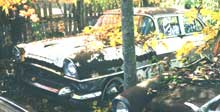In April 1941, Packard Motor Car Company introduced the new Clipper model. A single streamlined sedan on the wheelbase of the traditional One-Twenty, its four-month sales equaled those of the One Twenty, itself a successful foray into the medium-priced field introduced in 1935. The One-Twenty was so successful that a six-cylinder version became available in 1937. But while these “junior Packards” were keeping the company afloat in the Great Depression, there was no mistaking a Six or a One-Twenty for one of the “Senior Packards,” like a Super Eight or a Twelve.
In 1942, “Clipperized” styling proliferated, including a new coupe model. After World War II, only Clipper models were built, the Senior cars having been dropped. (A persistent legend holds that their tooling was sold to Russia. If so, it wasn’t used, because the ZIS, the USSR’s Packard look-alike, shares no sheet metal with any Packard model.)
Packard introduced the new Twenty-Second Series “Pregnant Elephant” cars in 1948. There were three lines of cars, Eight, Super Eight and Custom Eight, but aside from different grilles and wheelbases, there was little to distinguish them, despite prices ranging from $2,275 to $4,175 (for standard wheelbase four-door sedans). They were competing with cars from Buick Super to Cadillac Fleetwood 75. Put another way, the Packard Custom Eight looked very much like the Eight but cost almost twice as much, whereas even the cheapest Cadillac, the Series 61, had character much different from a Buick. Alfred Sloan’s “Car for every purse and purpose” was much more than a trite slogan.
With the Twenty-Fourth Series in 1951, the situation was the same, the $3,662 Patrician 400 being only subtly different from the 200 Business Coupe, which sold for $2,302. James Nance, the Hotpoint executive who became Packard’s president in 1952, believed that Packard needed a “Buick.” He re-introduced the Clipper name for the cheapest 1953 cars, then further differentiated the 1954 Clipper from the Patrician with its own tail treatment.
Nineteen fifty-five brought a new skin on the old body, V8 engines and “Torsion Level” self-adjusting suspension, though entry-level Clippers made do with a conventional coil-and-leaf spring setup. Clipper trim, particularly in the rear, was completely different from that of the Patrician. For ’56, Nance went all the way, taking the Packard name off the Clipper entirely, and forcing dealers to sign new Clipper franchise agreements. An upscale Executive model on the Clipper’s wheelbase was introduced in March, selling for $700 less than the Patrician. Whether the Nance dance could have helped Packard we’ll never know. Time had run out, Nance was sacked and 1957 Packards became gussied-up Studebakers, all of which were Packard Clippers. By July 1958, they too were gone.

